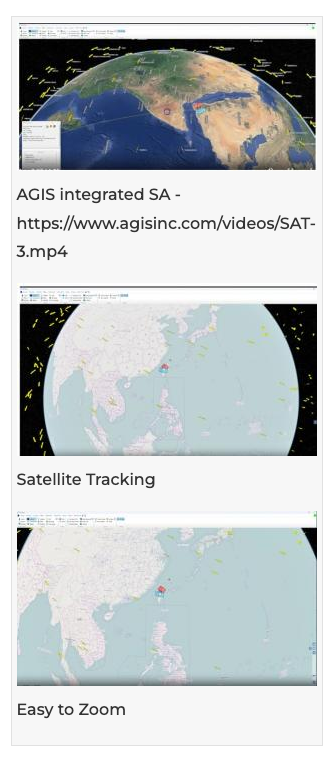 Using advanced algorithms to monitor and visualize positions of satellites in Earth’s orbit.
Using advanced algorithms to monitor and visualize positions of satellites in Earth’s orbit.
AGIS stays at the leading edge of software enhancements on situational awareness data processing.”— Malcolm K. Beyer, CEOJUPITER, FL, USA, March 25, 2024 — In a development that promises to revolutionize space monitoring and navigation, a cutting-edge technology has been unveiled that enables the tracking of all orbiting satellites around the globe in real-time. This innovative capability allows for the visualization of satellite locations and the multinational common operational picture (COP) on a single pane of glass, thereby providing a comprehensive and dynamic common operating picture for operators. As it stands, there is no other CJADC2 system that has achieved this level of situational awareness data integration. The satellite location data as seen on an AGIS COP can be selectively and automatically translated and transmitted on Link-16 and other data links.
AGIS stays at the leading edge of software enhancements on situational awareness data processing.”
— Malcolm K. Beyer, CEO
The AGIS C5ISR system can select the satellite’s country of ownership. With this country identification information, COP operators can know when hostile country’s satellites may be passing over ships and ground positions. This early warning of potential surveillance or reconnaissance activities will enable friendly units to take necessary precautions, such as adjusting their positions or communications, to avoid detection and potential attacks.
Conversely, knowing when friendly satellites pass over hostile ships and ground unit locations provides valuable intelligence on enemy movements, positions, and activities, enabling commanders to gather critical information for planning and executing operations effectively. By leveraging data that may be gathered from friendly satellites passing over enemy territory, warfighters can conduct targeted strikes, disrupt enemy communications, or coordinate with allies on synchronized actions. This real-time situational awareness enhances operational effectiveness, giving friendly forces a strategic advantage in engagements with hostile units.
The ability to monitor satellite movements adds to the totality of available intelligence. This can offer valuable insights and actionable intelligence that contributes to better decision-making. With satellite monitoring information, leaders may be able to extend their strategic and tactical capabilities and effectively respond to situations in dynamic and complex battlefield environments.
The system can be operated anywhere in the world, and so can the areas that are being assessed. By correlating satellite overpass information with data from tactical data links, Electronic Intelligence (ELINT), Synthetic Aperture Radar (SAR), Optical Imagery, and Communications Intelligence (COMINT), operators can gain a more comprehensive understanding of the operational environment and enemy activities.
By cross-referencing satellite overpass information with ELINT data, commanders can identify potential electronic threats, detect enemy radar sites, ships, and vehicles, and assess their detection and electronic warfare capabilities. This integration helps in developing countermeasures and adjusting tactics to mitigate electronic vulnerabilities effectively.
By correlating satellite overpass information with optical imagery, commanders can verify enemy positions, assess battlefield conditions, and monitor changes in the operational area. This integration enables accurate target acquisition, reconnaissance, and surveillance for informed decision-making in tactical engagements.
Overall, by integrating information on satellite overpasses with data from various battle condition sources, commanders can create a comprehensive operational picture, enhance situational awareness, and make informed decisions to achieve mission success in dynamic and complex military environments. This holistic approach to data fusion and analysis enables leaders to leverage multiple intelligence sources effectively, adapt to changing battlefield conditions, and execute tactical operations with precision and agility.
The implications of this new capability are far-reaching, with potential applications in satellite communication, navigation, Earth observation, and space situational awareness. By enabling a comprehensive view of the global satellite landscape, AGIS continues its work on further enhancements that open new commercial possibilities for optimizing satellite operations, ensuring orbital safety, and enhancing overall space command and management.
As the space industry continues to expand and evolve, the ability to track and monitor the locations of orbiting satellites in real-time represents a significant advancement in space technology. With this innovative capability, the future of satellite tracking, space navigation and space-based data is set to enter a new era of precision, efficiency, and safety.
AGIS stays at the leading edge of software enhancements on situational awareness data processing. The era of real-time satellite tracking has arrived, bringing with it a new frontier of reliability of space-based data and effectiveness of satellite operations.
Malcolm K. Beyer, Jr.
Advanced Ground Information Systems (AGIS), Inc.
+1 561-744-3213
beyerm@agisinc.com
See Global Satellite Locations in Real Time on C5ISR COP screen
